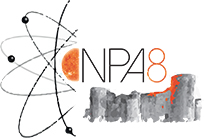Speaker
Dr
Anu Kankainen
(University of Jyväskylä)
Description
%
% Nuclear Physics in Astrophysics 8 template for abstract
%
% Format: LaTeX2e.
%
% Rename this file to name.tex, where `name' is the family name
% of the first author, and edit it to produce your abstract.
%
\documentstyle[11pt]{article}
%
% PAGE LAYOUT:
%
\textheight=9.9in
\textwidth=6.3in
\voffset -0.85in
\hoffset -0.35in
\topmargin 0.305in
\oddsidemargin +0.35in
\evensidemargin -0.35in
%\renewcommand{\rmdefault}{ptm} % to use Times font
\long\def\TITLE#1{{\Large{\bf#1}}}\long\def\AUTHORS#1{ #1\\[3mm]}
\long\def\AFFILIATION#1#2{$^{#1}\,$ #2\\}
\begin{document}
{\small \it Nuclear Physics in Astrophysics 8, NPA8: 18-23 June 2017, Catania, Italy}
\vspace{12pt}
\thispagestyle{empty}
\begin{center}
%%%
%%% Title goes here.
%%%
\TITLE{Measurement of key resonance states for the $^{30}$P$(p,\gamma)^{31}$S reaction rate}\\[3mm]
%%%
%%% Authors and affiliations are next. The presenter should be
%%% underlined as shown below.
%%%
\AUTHORS{A. Kankainen$^{1,2}$, P.J. Woods$^1$, H. Schatz$^{3,4,5}$, T. Poxon-Pearson$^{3,4,5}$, D.T. Doherty$^1$, V. Bader$^{3,4}$, T. Baugher$^{3}$, D. Bazin$^{3}$, B.A. Brown$^{3,4,5}$, J. Browne$^{3,4,5}$, A. Estrade$^1$, A. Gade$^{3,4}$, J. Jos\'{e}$^{6,7}$, A. Kontos$^3$, C. Langer$^3$, G. Lotay$^1$, Z. Meisel$^{3,4,5}$, F. Montes$^{3,5}$, S. Noji$^3$, F. Nunes$^{3,4,5}$, G. Perdikakis$^{5,8}$, J. Pereira$^{3,5}$, F. Recchia$^3$, T. Redpath$^8$, R. Stroberg$^{3,4}$, M. Scott$^{3,4}$, D. Seweryniak$^9$, J. Stevens$^{3,5}$, D. Weisshaar$^3$, K. Wimmer$^{8}$, R. Zegers$^{3,4,5}$}
%%%
{\small \it
\AFFILIATION{1}{University of Edinburgh, Edinburgh EH9 3JZ, United Kingdom}
\AFFILIATION{2}{University of Jyvaskyla, P.O. Box 35, FI-40014 University of Jyvaskyla, Finland}
\AFFILIATION{3}{National Superconducting Cyclotron Laboratory, Michigan State University, \\East Lansing, Michigan 48824, USA}
\AFFILIATION{4}{Department of Physics and Astronomy, Michigan State University, \\East Lansing, Michigan 48824, USA}
\AFFILIATION{5}{JINA Center for the Evolution of the Elements, Michigan State University, \\East Lansing, Michigan 48824, USA}
\AFFILIATION{6}{Departament de F\'{i}sica, EEBE, Universitat Polit\`{e}cnica de Catalunya, E-08019 Barcelona, Spain}
\AFFILIATION{7}{Institut d'Estudis Espacials de Catalunya, E-08034 Barcelona, Spain}
\AFFILIATION{8}{Central Michigan University, Mount Pleasant, Michigan 48859, USA}
\AFFILIATION{9}{Argonne National Laboratory, Argonne, Illinois 60439, USA}
}
%%%
\vspace{12pt} % Do not modify
% Enter contact e-mail address here.
\centerline{Contact email: {\it anu.kankainen@jyu.fi}}
\vspace{18pt} % Do not modify
\end{center}
%%%
%%% Abstract proper starts here.
%%%
Lack of knowledge of the rate of proton capture on radioactive $^{30}$P is the most prominent nuclear physics uncertainty in models of oxygen neon (ONe) nova explosions [1,2]. Recently, the $^{30}$P$(p,\gamma)^{31}$S reaction has been studied using the $d(^{30}$P$,n)^{31}$S reaction as a surrogate [3]. A primary beam of $^{36}$Ar (150 MeV/A) impinging on a Be target was used to produce the $\approx 30$-MeV/u $^{30}$P beam, which was separated with the A1900 fragment separator [4] at the National Superconducting Cyclotron Laboratory. The radioactive $^{30}$P beam bombarded a 10.7(8)-mg/cm$^2$-thick CD$_2$ target surrounded by the Gamma-Ray Energy-Tracking In-beam Nuclear Array GRETINA [5]. The $^{31}$S ions were analyzed by the S800 spectrograph [6] and identified by energy-loss and time-of-flight measurements. The $\gamma$-rays from the decays of excited states above the proton threshold in $^{31}$S were detected in coincidence with the recoiling $^{31}$S ions. Angle-integrated cross sections for the key resonances were determined and compared with theoretical $(d,n)$ cross sections.
In this contribution, I will discuss the first experimental constraints on spectroscopic factors and strengths of key resonances in the $^{30}$P$(p,\gamma)^{31}$S reaction. In general, negative-parity states have been found to be most strongly produced but the absolute values of spectroscopic factors are typically an order of magnitude lower than predicted by the shell-model calculations employing WBP Hamiltonian for the negative-parity states. The results clearly indicate the dominance of a single $3/2^-$ resonance state at 196 keV in the region of nova burning $T\approx0.10-0.17$~GK, well within the region of interest for nova nucleosynthesis. Hydrodynamic simulations of nova explosions have been performed to demonstrate the effect on the composition of nova ejecta.
\bigskip
{\small
\noindent [1] C.~Iliadis, R.~Longland, A.~Champagne, A.~Coc, and R.~Fitzgerald, Nucl. Phys. A 841, 31 (2010);
\noindent [2] J.~Jos\'{e}, A.~Coc, and M.~Hernanz, Astrophys. J. 560, 897 (2001);
\noindent [3] A. Kankainen, P.J. Woods et al., Phys. Lett. B (2017);
\noindent [4] D.J. Morrissey et al., Nucl. Instrum. Meth. Phys. Res. B 204, 90 (2003);
\noindent [5] S. Paschalis et al., Nucl. Instrum. Meth. Phys. Res. A 709, 44 (2013);
\noindent [6] D. Bazin et al., Nucl. Instrum. Meth. Phys. Res. B 204, 629 (2003).}
%%%
%%% End of abstract.
%%%
\end{document}
Author
Dr
Anu Kankainen
(University of Jyväskylä)

